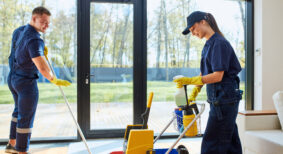Regular evaluation of safety strategies is crucial to ensuring a secure, comfortable and optimal learning environment for students and faculty. While school officials should have a regular cadence for assessing their security measures, schedules tend to become overwhelming during the school year.
Observed annually in June, National Safety Month is an excellent reminder to conduct an audit of existing infrastructure and determine where upgrades can be made to improve security, fire and life safety on campus.
The following tips can help school officials take the necessary steps in order to enhance their safety program and provide the proper protection for students and faculty.
Enlisting a security, fire and life safety provider for a streamlined campus assessment
Reviewing current security, fire and life safety technologies is a large undertaking for school officials. Partnering with an expert provider can help ensure the audit is done correctly and thoroughly. For example, seamless evacuation plans are crucial to protecting students and faculty in the event of a fire. Throughout the year, a school can run ongoing fire drills, but it’s difficult for school officials to identify risk areas if a fire has never occurred. A security, fire and life safety provider can conduct a comprehensive audit of all existing safety systems, not only fire. This approach ends up being more efficient in the future because if there is a threat to a fire or life safety application, then it’s likely a security technology may also be affected.
Along with detecting areas of improvement, an expert provider can pinpoint where siloed systems would benefit from integration. School leaders may be surprised to learn that connecting security, fire and life safety systems does not require a rip and replace of existing infrastructure. In fact, the current technologies can act as the foundation for integration and lead to more cost-effective upgrades.
Systems integration for improved security
In Canada, systems integration was identified as one of the top technology trends to have the biggest impact on the implementation of smart buildings over the next five years, according to Johnson Controls 2018 Energy Efficiency Indicator Survey. It’s important for educational institutions to move in this direction as well as a more efficient and secure campus can ultimately be more attractive to parents when deciding where to send their children and prospective teachers when choosing where to work. By working with school officials to determine their specific needs, an expert provider can take their feedback to implement connected security, fire and life safety strategy. For instance, preventing intrusion is a common goal among school leaders in K-12 and higher education. Video surveillance, visitor management systems and access control are examples of technologies that many institutions have in place to stop unwanted guests from entering, however, they can be more powerful when updated and connected.
Video analytics software can be installed to cameras on campus to analyze and classify movements and provide more insight to happenings on the premises without security personnel having to watch hours of recordings. Badges used for visitor management can be upgraded to track user statistics, like where students spend the most time on campus, and the data can be leveraged to improve safety on school grounds. Access control can move to a hosted platform to permit remote monitoring which can enhance after-hours security since parking lots and entrances can be remotely managed via computer or smart device. After these once traditional security systems become more advanced, integration becomes more powerful and easier. It also enables direct communication between once siloed systems to provide actionable, real-time insights in the event of an intruder.
Integrated security systems may also be connected to more building systems, such as fire alarms, lighting and HVAC. Lighting applications can be fixated on top of video cameras and fire alarms to help better guide students and faculty to the most appropriate evacuation routes should a fire breakout, and HVAC sensors can be integrated with these systems to limit the oxygen levels directed into the open flame to prevent the fire from spreading. Ultimately, connected platforms can help improve the exchange of information across a school’s campus when responding to emergencies, which can include security teams and law enforcement.
Safety strategies for emergency situations
Alerting outside safety resources to changes to the security, fire and life safety systems on campus is crucial to ensure that they can most effectively provide assistance during a crisis. School leaders should first plan to train campus security teams on how to operate the new implementations and educate them on any changes to safety policies if they needed to be revised as a result. Once the on-site staff is prepared, law enforcement should also be made aware of any updates that would impact how they respond to issues on campus.
While educating personnel on new technologies, school leaders should also consider supplying law enforcement and security teams with an emergency kit. Materials should include floor plans, access cards and the phone numbers of school officials that should be contacted by emergency responders. This deceptively simple safety component can be a critical asset if any technologies fail during an incident where the campus is depending on them to address the problem. In the event of an active shooter, certain doors could be closed via access control systems. The access cards become crucial in this situation as law enforcement officers need the badges to enter threatened areas and properly protect students and faculty.
School officials play a key role in ensuring that the investments they make in updating and connecting their security, fire and life safety systems see a return-on-investment, and a major part of that is making certain security teams and law enforcement officials are given the tools they need to help. Officials are also responsible for seeing that the technologies work to their full potential.
Maintaining security, fire and life safety systems for the future
An updated security, fire and life safety strategy can only operate at its full capacity when it’s regularly maintained. It’s vital for school officials to establish clear guidelines for upkeep in order to reap the eventual cost benefits of an integrated and more efficient approach to campus safety.
This National Safety Month, take the time to evaluate the effectiveness of your school’s security, fire and life safety strategy. What foundational pieces are missing? Are there opportunities to implement integrated systems? Does your campus have a strong emergency response system in place, and is it well known? Apply these questions and the tips suggested in this article to create a safer learning environment for students and faculty.
Julie Brown is the institutional market leader for Johnson Controls Building Solutions North America. She is responsible for driving business results for key market and customer segments within the North American healthcare and education institutional verticals.








